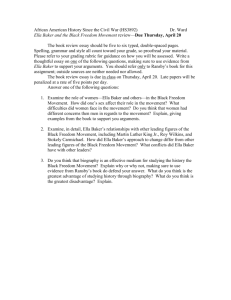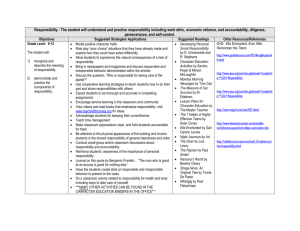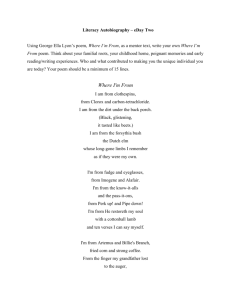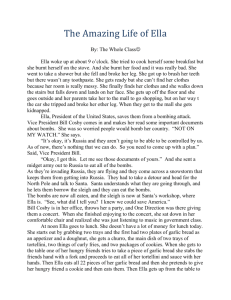Ella’s Kitchen: The World’s First Global Organic Baby Food
advertisement
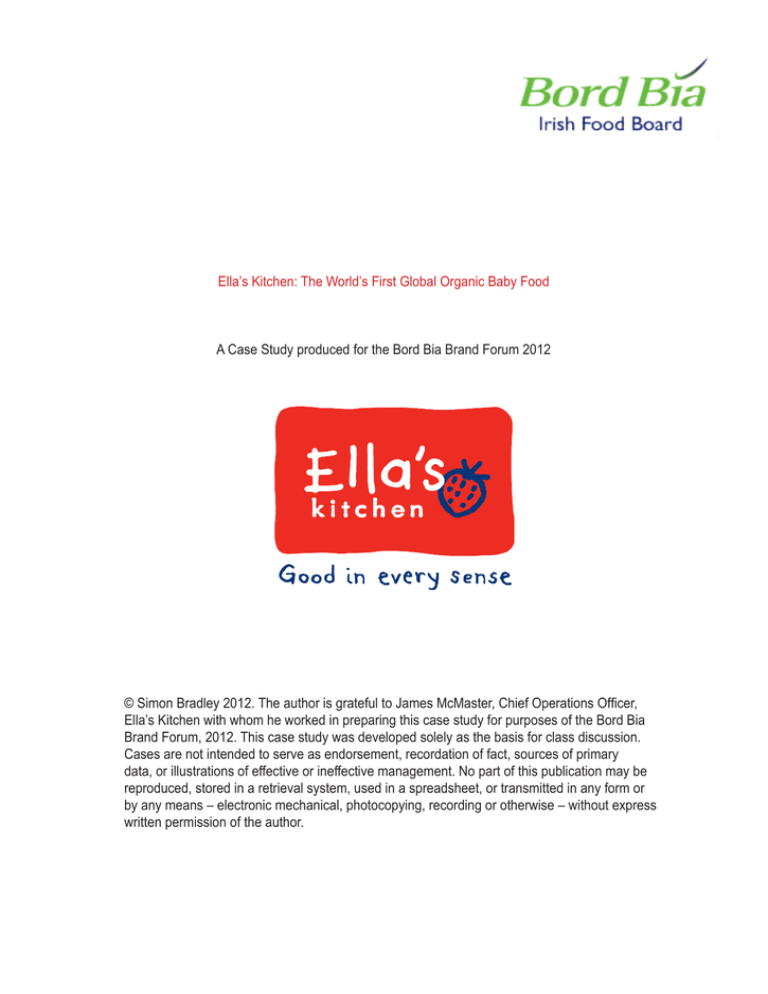
Ella’s Kitchen: The World’s First Global Organic Baby Food A Case Study produced for the Bord Bia Brand Forum 2012 © Simon Bradley 2012. The author is grateful to James McMaster, Chief Operations Officer, Ella’s Kitchen with whom he worked in preparing this case study for purposes of the Bord Bia Brand Forum, 2012. This case study was developed solely as the basis for class discussion. Cases are not intended to serve as endorsement, recordation of fact, sources of primary data, or illustrations of effective or ineffective management. No part of this publication may be reproduced, stored in a retrieval system, used in a spreadsheet, or transmitted in any form or by any means – electronic mechanical, photocopying, recording or otherwise – without express written permission of the author. F or Ella’s Kitchen, a rapidly growing €70 million organic baby foods company, the summer of 2011 presented an entirely new set of management challenges. Moving beyond an export model, it was opening a subsidiary office in New Jersey, USA, which would manage production, marketing and sales for the entire North American territory. Called the Treehouse in keeping with the company’s fun and child-oriented culture, this expansion was always part of the vision and development plan for Ella’s Kitchen. But the company co-founders, Paul and Alison Lindley and their growing team of 45 personnel were conscious such new growth would present challenges along with incredible opportunities for the brand. US market contributed 20% of total revenues and the goal for 2012 was that figure would rise to 30%. Meanwhile, Lindley and his team wondered what if anything would have to change in Ella’s Kitchen to ensure the brand values and communications remained consistent as the company entered this new phase of phenomenal growth. back to the community. C hildren and the way they viewed the world was valued as a source of inspiration and a model for adults to aspire to and apply in the world of business. This made for a warm, fun tactile company culture and brand that appealed to all five senses in terms of its marketing communications activities. Furthermore, using illustrations of the eponymous Ella infused the brand with personality and Focusing on the Consumer an emotional connection for parents rom a business perspective, what and children alike. was remarkable about the Ella’s et the catalyst was the sense of Kitchen story was its phenomenal rate cause, which the Lindleys shared of growth fuelled by its instantaneous nationwide brand status, product with their customers by continuing to innovation and passionate cause make products based on a ‘nothingadded’ policy; free from sugar, salt, related marketing. Reflecting on the additives and often certified 100% organic. This commitment to quality through purity made the branding ince its foundation in 2006, Ella’s credible and allowed Ella’s Kitchen Kitchen (Ella’s) had been blazing command a significant premium a trail through its domestic UK market, in an otherwise low-margin sector. shaking up a relatively stale product Expanding internationally, the category with its range of colourful, company had initially focused on playful, pure and organic baby foods. exporting to markets similar to the UK Soon after, Ella’s internationalized, in terms of size and structure; Sweden exporting to Norway, Sweden, Ireland and Norway specifically. Additionally and subsequently the USA. Named health and wellness were considered after the Lindley’s daughter, Ella’s important consumer values in Kitchen was created with the idea Scandinavia, which facilitated market of promoting healthier eating habits penetration. among the world’s children, tackling obesity and making food fun for toddlers. Reasoning that children Acorns to Oaks across cultures were more similar Ella’s Kitchen story, the company’s than they were different, early on in the Head of Doing Things Smartly, James aul Lindley was a trained business’ development, management McMaster attributed its success to accountant who had risen quickly had set their sights on the ultimate date to a relentless focus on their through the ranks of children’s goal- to create the world’s first truly consumers - young children - by television channel Nickelodeon global premium food brand for pre- leveraging ‘pester power’ positively. during the 1990’s. At 34 he was school children. And in that vein, employees were appointed Managing Director and encouraged to look at the world from two years later he was already ith the US launch, CEO a child’s point of view. In fact its entire seeking a new challenge. When Paul Lindley considered the business strategy adhered to this on a family holiday, his two year challenges of developing a global ethos from new product development old daughter Ella suddenly began brand across cultures from at least to packaging, to marketing and giving refusing foods she used to enjoy, two different offices. Already the F Y S P W a seed of inspiration germinated in Lindley’s imagination. Researching the baby food sector he became convinced Ella’s food was failing to stimulate her senses appropriately – the colour, the packaging and the tastes were bland and un-inspiring in his opinion. Ella needed to enjoy the eating experience. Over the following months the couple developed their idea into a business proposition and a mission focused on bringing healthy nutritious additive-free food, packaged in fun and exciting ways, to the UK’s toddlers. For the Lindleys the deal was a coup. W ithout selling a single item they had entered the UK kids food market with two fruit smoothie pproaching Nickelodeon’s owners, Viacom Brand Solutions, recipes, the Red One and the Yellow Paul Lindley pitched the idea of One so named by their children buying advertising space on the during a tasting test at the kitchen television channel in exchange table when the children referred for a share in sales revenue. The to the products by the colour of proposition appealed because the their packaging as opposed to the creative idea behind the spots for the flavours inside. For the co-founders new Ella’s Kitchen brand promised it was another serendipitous moment, to keep viewer attention and presenting valuable insights into the minimize channel zapping. Further, psychology of their target customers, Nickelodeon realized that the positive visual cues informed preferences and y that stage, the Lindleys were publicity from involvement in a project even emotional states. ready to commit £20,000 – the that promoted healthy eating among family’s life savings - to developing its target audience presented a clear the idea into a market ready product. opportunity for enhancing its own Product Innovation – Central to Guided by their mission they knew market positioning as a sponsor of Growth that building sales one shop at a time healthy eating among its viewers. would kill momentum and scupper o finance the initial production any chances of success. Instead, ith the revenue-share agreement run, the Lindleys re-mortgaged the Lindleys decided to create a in place, the Lindleys presented their family home for £200,000, branded product that supermarkets product samples; the brand vision outsourcing manufacturing to the could buy into readily. First off, Paul and marketing plan to Sainsbury’s, a company who had helped develop his Lindley commissioned a group of nationwide UK retailer. Impressed trademark re-sealable pouches. food scientists at Reading University to formulate the couple’s smoothie recipes to retail standards while he sourced companies that could deliver a solution to the packaging conundrum of making the product appear playful and fun to a child’s mind. Once standards could be established, production would be outsourced to a trusted supplier. Marketing Strategy A B W T M eanwhile, locating a UK company that could produce squeezable yet sturdy pouches, the Lindleys developed a suitable fun tag line for the concept product – “shake me, squeeze me, slurp me” – that would appear on all pouches. They then turned attention to the challenge of launching a national brand without ever having sold a single pouch. The gut feeling was that the marketing strategy should leverage pester power in a positive way. with their innovative product concept, the retailer was also reassured by the advertising deal already in place, which would reach 40% of UK schoolchildren. The supermarket agreed to stock Ella’s Kitchen in 350 stores across the UK on an exclusive basis for a trial run in January 2006. While the pouches were not recyclable, they could be transformed or ‘upcycled’ into new products such as bags and bibs for example, something which the company focused on in its community engagement initiatives. Furthermore, they required 80% less material to make than the equivalent glass jar, Tetra Pak or PET plastic bottle did. This low environmental impact was an intrinsic part of the brand’s value system. 2010 it was recognized as one of the UK’s fastest growing companies as it shook up UK baby food sector, which had been considered a loss-leader by most retailers. Instead, their lla’s Kitchen started out innovative approach had spawned producing a small range of fruit several new competitors eager to smoothies marketed in its distinctive capitalise on the value growth in the trademarked squeezy pouches, industry in the interim years. As such, selling at a premium. As sales grew, while the core product continued to the company quickly expanded its offer a compelling USP, Ella’s Kitchen range into stage one and stage two had also nurtured and tweaked its baby foods. Stage one foods were marketing communications strategy designed for new-born babies while to consolidate their leadership stage two products featured foods position in the UK sector. By late with more textures and stronger 2010 the company had captured 15% flavours. Designed to be both fun of the UK ‘wet’ baby-food market for children to eat from and sturdy and was elected the Food and Drink enough to that they would not burst Brand of the Year at the UK Grocer easily in mum’s handbag or dad’s Gold Awards. pocket for example, the food could be served directly from a re-sealable pouch cold or heated in a bowl of Holistic Approach to Branding water. lla’s Kitchen was a model of ventually Ella’s Kitchen leveraged 21st century food branding. The its healthy credentials extending identity and the ethos of the brand the brand into snacks for toddlers remained consistent throughout its and parents alike including cookies meteoric growth. The E E E after quality control and sourcing ingredients and packaging but we outsource manufacture to a number of trusted, expert manufacturing partners”. The fact that very few companies could replicate their distinctive pouch packaging afforded them an edge on market followers who entered the baby food market subsequently with other premium organic baby food propositions. T he pre-launch deal with Viacom had catapulted Ella’s Kitchen from concept to fully-fledged brand in a heartbeat and appeared to play a crucial role in its initial success. Management were, however, aware they needed to develop and refine marketing communications in tandem with the advertising to flesh out the brand and involve their customers in the Ella’s ethos. The value of an illustrated character based on Ella Lindley to represent the brand could not be underestimated, forging an emotional link with customers, which other marketing communications would have to consolidate. F or customers and employees alike, Ella’s mission was exciting. A strong web-presence was deemed important to nurture a sense of community and interact with customers, promoting the Ella’s ethos of healthy eating and sustainability through information, competitions and activities. Between the product and the website, Ella’s Kitchen’s marketing activities addressed all five senses. In late 2011 Ella’s Kitchen launched its Tasty Tunes campaign featuring versions of wellknown nursery rhymes available oat finger bars and a range of sauces. Lindleys focused their efforts on for download on the website that All products were manufactured developing these intangible assets promoted eating vegetables as according to the company’s ‘nothing- while outsourcing other aspects of enjoyable. The Tasty Tunes initiative added’ policy that meant no added the value chain. Explaining their stemmed from research undertaken sugar, salt or additives, while all business model Lindley commented, which indicated that less than 20% products available in its range were “we develop the recipes and look of under-fives ate the recommended certified 100% organic. In 2009 and ‘five-a-day’ of vegetable and fruit , servings. And in that sense, the First Export Markets: linchpin to the success of Ella’s as Scandinavia it grew exponentially, appeared to be that the entire company lived and hereas exporting theory breathed the Ella’s brand. indicated small businesses tended to target international markets randing inside – where employees culturally most similar to their own acted as brand ambassadors- or those physically closest, Ella’s played a central role in sustaining Kitchen focused on comparable growth and the credibility of Ella’s markets. With such rapid growth positioning in the market. By taking rates and a readily accessible brand, personal ownership of the Ella’s management felt it was a question Kitchen story and vision, personnel could act as brand ambassadors. As part of that approach, the founders nurtured an organizational culture that shared their sense of fun and childlike perspective. For example, staff were encouraged to question the status-quo much as a child might and not to accept ‘no’ for an answer, much as a precocious toddler might. The idea was that such attitudes would foster innovation and entrepreneurialism; key ingredients in a young dynamic business. B F urthermore, management believed that replacing the term Sales Turnover with the concept of Tiny Tummy Touchpoints refocused energies on the core aim and higher goal of promoting healthy eating among babies and toddlers. In 2012 it was estimated that every second of every day someone, somewhere was consuming an Ella’s Kitchen product, which placed the company on track to break the 200 million Tiny Tummy Touchpoints milestone by mid 2012 with aims to reach 1 billion within 5 years. These figures represented cumulative product sales but more importantly for Ella’s Kitchen, they indicated the success of promoting their healthy eating agenda worldwide. In fact, according to one survey of 10,000 women in the UK, Ella’s Kitchen had succeeded in building the most trusted food brand and the 16th most trusted brand generally in the UK in 2011. W predisposed to healthy eating habits and family incomes were sufficiently high enough to pay the premium price. These criteria and ‘gut-feeling’ as to the appropriateness of a given market remained as guiding lights in terms of international market selection and targeting. A s such management believed minor tweaking of the export marketing strategy would gain market penetration via national supermarket retail chains. With the help of UKTI Ella’s Kitchen identified and engaged local distributors and consultants to manage the final leg of the distribution process and to help with language and cultural nuances, ith the assistance of the ensuring the brand’s message was United Kingdom Trade & communicated correctly. Reflecting Investment (UKTI) body, and the on the similarities between the Food From Britain Initiative, the domestic and international markets, Lindleys identified opportunities in Paul Lindley explained, “the products Scandinavian markets. By 2012 are the same as for the UK market, the company had captured 20% but as Swedish children don’t go to market share in Norway and 10% in school until they are seven and don’t Sweden, attributable to many of the take packed lunches, our lunchboxsame reasons as its success in the snack products aren’t sold in the same way as they are in the UK”. domestic market. of when rather than if they entered foreign markets. Conversely that was tempered by an understanding of the need to focus on developing certain markets rather than chasing opportunities across many. W T he Lindleys prioritised Sweden and Norway, with the reasoning was that the markets and distribution structures were relatively similar to those in the UK, were big enough to be interesting while consumers seemed Growth through Exports: USA B etween the time Ella’s Kitchen entered the US market in 2009 and the time it decided to open its US subsidiary, stateside brand sales grew from zero to £15 million generated from 12 products in its range. Management believed US sales could reach £30 million by the end of 2012. potential issues that could dilute the cohesion and team spirit. Some of these issues included the need to hire and retain top talent, adherence to the company’s local sourcing policy and to its green ethos with W hile the US had always featured in management’s expansion plans, Ella’s journey west was triggered by an unsolicited request from a US retailer. It was this entrepreneurial attitude, which convinced Ella’s Kitchen management they had made the right choice in focusing on the US market. Later, selling through retailers including Target, Whole Foods Market and Kroger, management realised they faced an enormous market opportunity as many of its US customers dwarfed the footprint of Tesco’s in the UK for example. With sales soaring to account for around a quarter of company turnover, Lindley and his management team resolved to commit further resources to developing the company’s position. Relocating their UK sales director, Douglas Struthers, a UK national to champion the new venture, the company established the Treehouse as its base in New Jersey. Struthers was tasked with recruiting a local team to support existing consultants, source the right raw materials to ensure the quality and consistency of supply and to manage and develop sales growth. respect to upcycling waste. Finally, if un-addressed, these together threatened to upset Ella’s positioning in the market as a fun, caring and environmentally sensitive premium brand. T o address talent management and development, McMaster and his team launched Ella’s Classroom as a training resource for all personnel. The business was growing fast and hiring dynamic and expert managerial talent from other high potential food brands while also trying to ensure consistency in the brand message Growing Pains for all its personnel. Commenting hile Ella’s Kitchen had on the concept, McMaster explained prospered internationally “Ella’s Classroom is about sharing so too management experienced knowledge across the business. We growing pains as the organization have some incredibly talented people and operation became larger and in the barn who run the ‘classes’ more complex in terms of sales, themselves, ranging from how to personnel numbers and locations. present effectively to making sense Management identified a number of of finance“. W C ommenting on the difficulty of sourcing supplies, Alison Lindley explained, “for the size and scale that we are, having to fulfill orders with all the major retailers, much as it would be lovely to source everything locally and seasonally within the UK, it’s just not possible. So we’re doing what we can to keep everything without going to far away. Most of the ingredients are sourced from within Europe and all comply with EU organic standards and we certainly don’t use any air-freight or anything”. Again growth prompted questions how the company would implement its upcycling scheme in large international markets, each differing in its environmental orientation. Looking Ahead T hese were points that industry commentators had not failed to notice, but whether they indicated the Ella’s Kitchen brand faced any fundamental problems in its medium term remained uncertain. Some analysts concluded that Ella’s Kitchen was fast approaching a crossroads in its journey where it might consider selling up the business to the highest bidder, leaving insiders to speculate how Ella’s Kitchen might develop over the longer-term under new ownership. I t was evident the Lindleys had achieved great success growing Ella’s Kitchen to €70 million in a few short years and they had not ruled out selling the business as an exit strategy. Yet, Alison Lindley was adamant that whoever owned the company, “our ultimate mission is to get as many children as possible eating healthily, and if that doesn’t change I’m not sure how much difference it makes” as to who owned the company and the Ella’s Kitchen brand. Returning to the more immediate concerns of the US expansion, the Lindleys and their UK team were busier than ever coordinating with the Treehouse team. With the substantial investment made in the US subsidiary, it was critical Ella’s Kitchen was in the best position to really crack the US market and reach the 1 billion Tiny Tummy Touchpoints milestone worldwide. Reflecting on that goal, Paul Lindley wondered whether Ella’s Kitchen was ready for this next big challenge. product and the marketing need to stand the test and evolve with the needs of the market. I nnovative marketing can help build a brand at scale. The Lindleys launched a national brand overnight by thinking big and developing a novel revenue share model, which suited both parties, Viacom and Ella’s. They still had to fulfill the brand promise with every SKU sold however. B randing internally becomes increasingly important as the business grows. Everyone in the team represents the brand, which is both an opportunity and a risk. A cohesive team working toward a common goal and vision can produce a strong culture, which will touch customers, suppliers and partners. I Key Learnings nitial export markets may be off the radar in traditional models. Comparable markets may not be culturally close but may share other appealing characteristics with the home market. Businesses can learn from different export markets but focus is often key to succeeding. E A s a business grows and organizational structures get more complex, management encounter new tasks and challenges in terms of sharing information and maintaining quality and/or consistency. Ella’s has addressed this with respect to sustaining a strong and vibrant company culture and a clear brand proposition. It will nevertheless continue to face challenges as it grows onsumers identify with causes. internationally- cultural differences With globalization there are more among its team and customers will and more opportunities to tap into mean the Ella’s story is vulnerable to trends and values that transcend misinterpretation. national borders and cultural barriers lla’s Kitchen is a perfect example and develop products that meet those of consumer oriented product needs. Championing a cause with a brand is not enough, however; the innovation. The importance of the Lindleys’ role in bringing that to lla’s is an example of branding excellence because it is cohesive - the product, the story, the use of sensory branding, language like The Treehouse and Tiny Tummy Touchpoints, the corporate culture and the management vision to bring it international from early on in its development. Its success is due to its ‘relentless focus on the consumer’. C E markets internationally cannot be overstated. Notes and Key Take Homes from Ella’s Kitchen:
